The content of the article
Adjika is considered a national Abkhaz delicacy, but its recipe is firmly rooted in every country. The dish can be prepared as a sauce and dry seasoning, it all depends on personal preference. The adjika is based on plums, tomatoes, apples. Chilli or horseradish is considered an essential ingredient, it is they who give the dish the desired spiciness. Often adjika contains spicy herbs, they allow you to achieve an exquisite aftertaste. The sauce is served to fish and meat dishes, it rightfully occupies an honorable place on the kitchen table of each family.
Traditional recipe adzhika
Abkhazian cooking technology is considered the basis of the basics, so it makes sense to consider it first. According to the national recipe, tomatoes are not added, a rich color is achieved due to hot red pepper.
- Red pepper (hot) - 0.9 kg.
- salt rock - 60 gr.
- garlic - 525 gr.
- a mixture of coriander, dill seeds, hops-suneli - 65 gr.
- Wear rubber gloves to protect your hands from burns. Optionally, you can make adjika less acute, taking not 900 gr. red pepper, and 400-500 gr. At the same time it can be replaced with paprika, judge by the desired result.
- Separate the stem from the pepper, wash the pods and remove the seeds. Pass the ingredients through the grinder several times (you can use a blender). Do the same manipulations with fresh garlic, after clearing it from the husk.
- Mix the pepper and garlic porridge with ground spices (hops-suneli, coriander, dill seeds), add salt. Stir the mixture with a fork until smooth, add cilantro and fresh chopped dill if desired.
- Classic cooking technology does not require boiling. Store adjika in the refrigerator for no longer than 5 months. Choose for aging glass or plastic containers with a tight-fitting lid.
Adjika with tomato paste
- chilli - 165 gr.
- fresh plum - 2.2 kg.
- fresh tomatoes - 600 gr.
- oil (preferably olive oil) - 125 ml.
- tomato paste - 220 gr.
- table salt - 60 gr.
- dill - 1 bunch
- Bulgarian pepper - 350 gr.
- granulated sugar - 145 gr.
- garlic - 300 gr.
- At will it is possible to take more tomatoes (for example, 700 gr.). Wash plums, remove bones, rinse with water again and dry with paper napkins.
- Remove the stem from the bell pepper, cut, clean the cavity of the seeds and rinse. Wear rubber gloves, wash and clean chili peppers, and dry.
- Peel the garlic, rinse the dill with water and coarsely chop it. Turn on the blender, first chop the fruits of the plums in it, then remove the porridge and move it into a deep bowl.
- Now cut the tomatoes into cubes, after removing the inedible parts. Pass the tomatoes through a blender. When they turn into porridge, add chopped chili, bell pepper, dill and peeled garlic.
- Take a deep dish with thick walls and bottom, move the porridge from the tomato, bell pepper, chili, garlic and dill into it. Add shredded plums, put on a slow fire.
- Boil a mass of about 50-60 minutes, during this time it will increase. Add tomato paste, salt, butter, sugar, mix, stew for another 1.5 hours at low power.
- After the allotted time has elapsed, turn off the hotplate, pour the mixture over the sterilized jars, roll it up. You can skip the last stage, packaging adzhika in glass containers. Refrigeration period is 6 months.
Adjika with apples
- carrots - 900 gr.
- sweet and sour apples - 1.1 kg.
- tomatoes - 2.6 kg.
- chili - 200 gr.
- Bulgarian pepper - 1.4 kg.
- salt rock - 25 gr.
- granulated sugar - 130 gr.
- vinegar solution (table, wine or apple) - 110 ml.
- garlic - 220 gr.
- horseradish - 200 gr.
- Wash all fruits and vegetables. Remove the apples and the cores from the apples, chop the fruits into orange slices. Peel the Bulgarian pepper from the seeds, cut into chunks. Wash the tomatoes, cut the stalks, peel the carrots.
- Wear gloves, rinse chili under running water, remove seeds, they will not be needed. Remove the husks from garlic, divide the head into individual cloves.
- Put the Bulgarian pepper, garlic, tomatoes, carrots, apples in the bowl of a blender, grind to the state of porridge. Transfer the mass to a thick-bottomed saucepan, put on a slow fire.
- Duration of cooking is 1 hour, during this period you need to grind in a meat grinder or chili blender, and then mix it with horseradish.
- After the specified period, add the power of the burner to the middle mark, send hot peppers with horseradish to the pan. Tomit another 45 minutes, then add salt and sugar, pour in vinegar.
- Re-bring the mass to the appearance of bubbles, leave for 10 minutes. Wash the glass jars with soda, dry. Pack the finished product in the container, roll up or twist the lids. After cooling, move the adjika into the refrigerator or cellar.
Adjika with plums
- sugar - 185 gr.
- plums - 4.3 kg.
- chilli pepper - 110 gr.
- dill - 1 bunch
- parsley - 1 bunch
- fine salt - 90 gr.
- tomatoes - 1.8 kg.
- garlic - 280 gr.
- Place the plums in a colander, wash thoroughly to remove the whitish color. Cut into 2 pieces, remove the bones. Put on gloves, rinse chili under cold water, remove the seeds and cut the leg.
- Now peel the garlic, you can replace it with onion white onions or table horseradish. Wash tomatoes, cut into cubes, remove inedible parts.
- Mix the plum pieces with chili, tomato, garlic / onion. Send vegetables to a blender or skip 3 times through a meat grinder. Pour the porridge in a thick-bottomed pot, put on the fire.
- When bubbles appear, reduce the power to the level between the minimum and average.Pour the sugar, fine salt, cook until the granules dissolve, stir constantly.
- The duration of languor is 1.5 hours. After 15 minutes, add chopped dill and parsley, after cutting off the twigs. While the mass is boiling, sterilize the jars and lids for further twisting.
- After the specified period has expired, pour the finished adjika into containers, tighten. Turn the container neck down, cool under natural conditions. Move to storage in the basement, refrigerator or cellar.
Adjika "gentle"
- Bulgarian pepper - 1.2 kg.
- ripe plum tomatoes - 2.8 kg.
- Chilli - 30 gr.
- garlic - 280 gr.
- granulated sugar - 30 gr.
- Table vinegar (concentration 9%) - 65 ml.
- salt - 55 gr.
- In the end, you get 3 liters of finished adzhika. The composition will not be too sharp due to the small content of chili peppers, if desired, the amount can be reduced.
- To ensure that the final product is not liquid, wash the tomatoes and dry them. Then chop into slices, move to a colander and leave over the dishes, for this period the juice will drain.
- Peel the seeds and legs from the chili, and do the same with the bell peppers.Chop the vegetables into slices, transfer them to the blender together with the tomatoes. Scroll to the state of porridge, add garlic and chop again.
- In the finished composition, add sugar and salt, pour vinegar solution. Put the prepared gruel into the pan, cook for about 1.5 hours, stirring occasionally. After that, pour into sterilized containers, roll up.
- Turn the container upside down, allow it to cool at room temperature. Take the finished adjika to a place of long-term storage, the cellar or the refrigerator is considered ideal.
- The composition can be consumed after 3 days after preparation. The shelf life is 3 months, subject to compliance with the optimum temperature (10-12 degrees).
Adjika with beets
- granulated sugar - 110 gr.
- garlic - 60 gr.
- drinking water - 265 ml.
- vegetable oil - 260 ml.
- beets - 1.9 kg.
- Bulgarian pepper - 260 gr.
- tomatoes - 750 gr.
- chili - 2 pods
- onion - 230 gr.
- Acetic Essence - 40 ml.
- salt - 30 gr.
- The cooking technology is different from all the others with a sweet spicy aftertaste, which is achieved due to the contained beets and chili peppers.
- Wash, clean the beets, cut it into cubes and place in a blender (you can scroll 3 times in a meat grinder).Peel the chili, remove the leg and seeds, mix with the sugar and salt. Send this mixture to a blender, scroll along with the beets.
- Remove the previous mass, put it in a bowl. Peel the tomatoes, if possible, remove the peel. Remove the seeds from the cavity of the Bulgarian pepper, cut the legs. Scroll the tomatoes with pepper in the meat grinder 2-3 times.
- Peel the onions, cut them in very thin half rings. Fry in a hot frying pan with the addition of sunflower oil (until golden crust). Add the porridge of tomatoes and peppers to the pan, pour in water. Tom mass a quarter of an hour.
- Put the beetroot in the pan, send a fry to the bowl. Put on the fire, boil for about 45 minutes under the lid. Stir periodically so that the mass does not stick to the walls.
- 10 minutes until ready, pour in the vinegar essence, add crushed garlic under a press. Pour the mixture over the cans, seal the cork tightly or tighten with plastic caps. Leave to cool, then transfer to cold storage.
Adjika with horseradish
- tomatoes - 550-600 gr.
- Chilli - 40 gr.
- Bulgarian pepper - 200 gr.
- fresh dill - 1 bunch
- fresh parsley - 1 bunch
- sugar - 20 gr.
- salt - 20 gr.
- Wine vinegar - 200 ml.
- horseradish grated - 80 gr.
- seasoning to taste
- garlic - 1 head
- Wash the tomatoes, pour them with boiling water, remove the peel. Cut the tomatoes in half, remove the seeds. Do the same with Bulgarian and chili peppers. Peel the garlic, divide the head into the teeth.
- Pass through a blender or a meat grinder with garlic, tomatoes, chili and bell pepper. Beforehand, grate the horseradish, add to the cooked pasta.
- Stir until uniform, move to a deep bowl, wrap the container with cling film. Put in the fridge for 20 hours. At the end of the period, remove and mix.
- Now add sugar, salt, add spices to taste. Wash and dry the parsley with dill, chop, mix with vinegar. Add mass to the previous mixture.
- Prepack the finished adjika in small banks, store in the refrigerator or cellar for no longer than 3 months. Serve with meat, fish, side dishes, seafood.
Consider cooking adzhika based on ripe plums, tomatoes, Bulgarian or chili peppers. Add your favorite spices as desired, make a sauce with beets, apples, horseradish or tomato paste.
Video: zucchini adjika

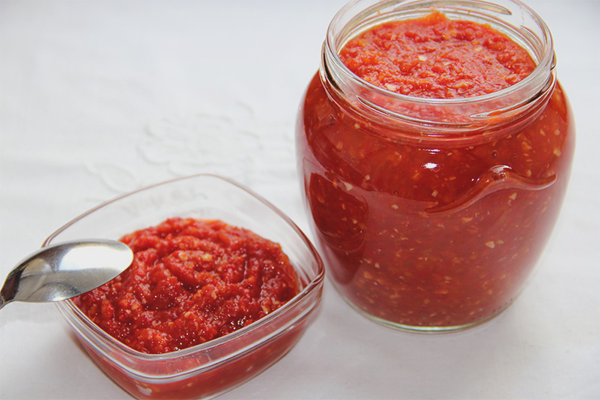
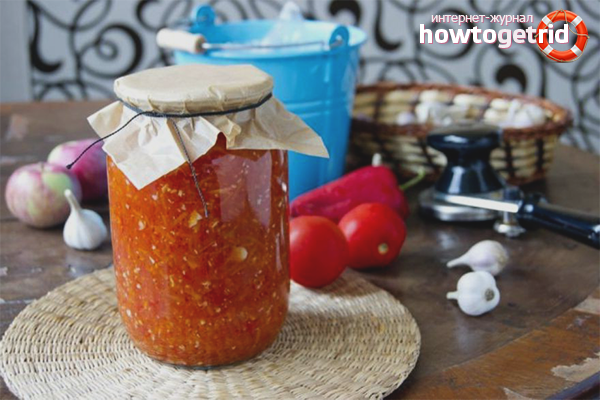
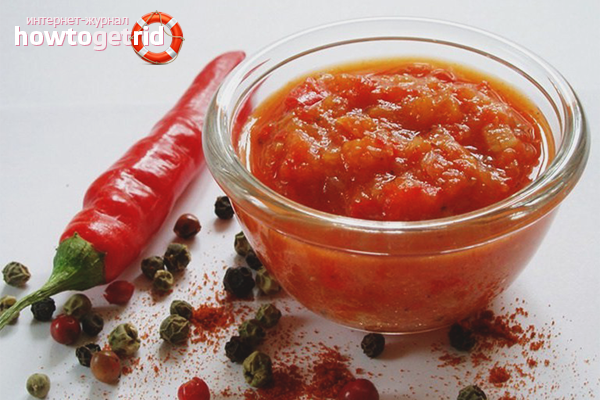
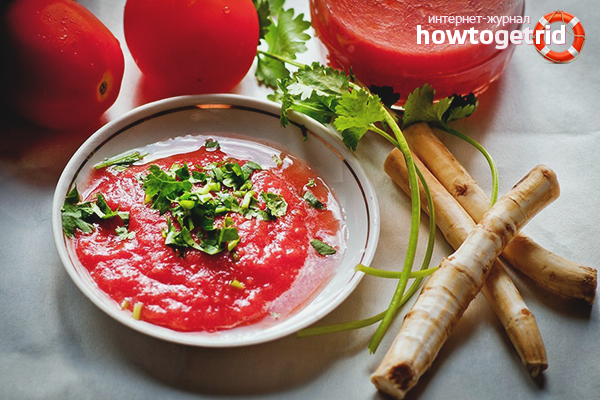


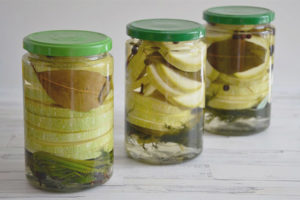
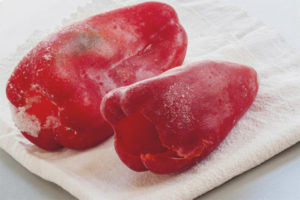
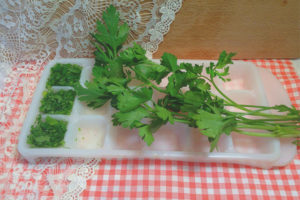
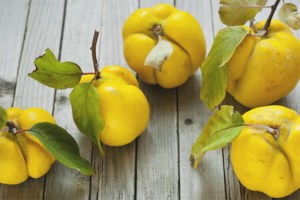
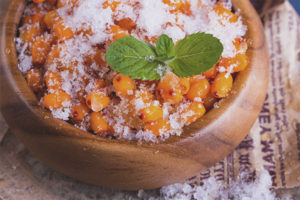

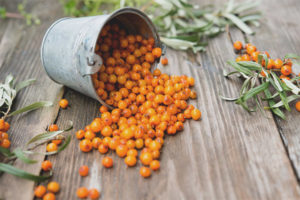
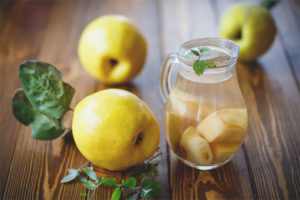
To send